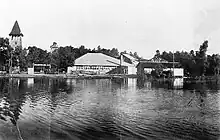The Wharton Studio
Wharton, Inc. was an early silent film production company in Ithaca, New York, from 1914 to 1919. One of the first independent regional centers of early filmmaking, the movie studio was established by brothers Theodore and Leopold Wharton on the shores of Cayuga Lake at the site of what is now Stewart Park. Currently, efforts are underway to create a silent movie museum in the former Wharton movie studio building in Stewart Park.[2]

Ithaca (1912 - 1920)
In late 1912, on his way to visit family in Ludlowville, New York, Theodore filmed a Cornell-Penn football game for Essanay, the Chicago studio that employed him as a director. Impressed with the singular beauty of the area, he convinced Essanay to allow him to return to Ithaca in the spring of 1913 for a full season of filming with a cast and crew that included such stars as Francis X. Bushman and Beverly Bayne.

The following year, Theodore was joined by his older brother Leopold, then a director at Pathé. Together, the two established their eponymous Ithaca studio and began producing short films, serial motion pictures, and eventually a few feature films. Their connections in the industry meant that the brothers were able to attract a number of major stars, many of whom arrived in Ithaca on the overnight train from New York City. The Wharton pictures were shot on elaborate sets that they created at their studio and in natural sites around Ithaca, including the gorges on the Cornell University campus, and they often used students and local citizens in their casts.

Later Years (1920 - 1931)
Despite the early popular and critical success of their serial productions, by late 1919 the Whartons were in serious financial trouble. Forced to give up their studio (which was sublet first by Grossman Pictures and then by Cayuga Pictures), the brothers parted ways, never to work together again. Leopold left Ithaca first, joining Macklyn Arbuckle at San Antonio Motion Pictures in Texas. Over the next two years, he produced a few minor films, all of them starring Arbuckle. Theodore did not fare much better. Since the majority of the film industry had by then settled in Southern California to capitalize on year-round shooting and to escape the Edison Trust[3], he headed to Santa Cruz, where Mayor Fred Swanton[4] was promoting and encouraging film production in the city and offering various concessions to filmmakers. Theodore hoped to establish a new studio there that would rival the former Wharton Studios in Ithaca. After several years, though, he left Santa Cruz without producing a single film. Eventually, he moved to Hollywood, where he assumed minor roles as a screenwriter and assistant director.
Leopold died in New York City in 1927. Theodore died a few years later, in 1931, in Hollywood. The serial films for which the Whartons were renowned in the 1910s had largely fallen out of favor with the moviegoing public; and much of the evidence of the brothers' prolific cinematic career was lost in 1929, when hundreds of their nitrate-based film reels spontaneously combusted in the storage shed at the home of their lawyer.[5] Today, the Wharton Brothers—among the first independent filmmakers to own and operate their own studio—are recognized as pioneers in the early film industry. In 1994, their first and best-known serial The Exploits of Elaine was named to the National Film Registry at the Library of Congress for its cultural and historic significance.
Films produced at Ithaca Studios

- The Crooked Dagger (1919)
- The Red Peril (1919)
- A Romance of the Air (1918)
- April Fool (1918)
- The Eagle's Eye (1918)
- Mission of the War Chest (1918)
- The Candidate (1918)
- The Missionary (1918)
- Below Zero (1917)
- The Great White Trail (1917)
- The Black Stork (1917)
- Patria (1917)
- The Crusher (1917)
- Beatrice Fairfax (1916)
- The Lottery Man (1916)
- The Mysteries of Myra (1916)
- Hazel Kirke (1916)
- The City (1916)
- The New Adventures of J. Rufus Wallingford (1915)
- The Romance of Elaine (1915)
- The New Exploits of Elaine (1915)
- The Stolen Birthright (1914)
- The Exploits of Elaine (1914)
- The Fireman and the Girl (1914)
- A Prince of India (1914)
- The Pawn of Fortune (1914)
- The Warning (1914)
- The Boundary Rider (1914)
References
- "Unique Stunt by Whartons". The Moving Picture World. June 17, 1916. Retrieved November 13, 2013.
- "Wharton Studio Museum -- Ithaca, NY | Making noise about silent film!". Archived from the original on 2016-10-26. Retrieved 2015-03-15.
- "Why Santa Cruz has been selected as the location for the studio and production activities of Wharton Film Classics, Inc". Wharton Film Studio Promotional Brochure. c. 1927. Archived from the original on January 10, 1998. Retrieved June 9, 2010.
- Ross Eric Gibson (February 1, 1994). "Hollywood Came to Santa Cruz: Huge Redwoods Seen as Western Backdrops". San Jose Mercury News. Retrieved June 9, 2010.
- "Wharton Studio History". Wharton Studio Museum - Ithaca, NY. Retrieved 6 March 2019.
External links
- List of films made at the Wharton Studio at IMDB
- "Resume of Mr. Wharton's Career". Wharton Film Studio Promotional Brochure. c. 1927. Archived from the original on January 10, 1998. Retrieved June 9, 2010.
- "Silent Film Industry Blossoms in Ithaca," Cornell Daily Sun. Available online.
- Ithaca Made Movies
- Ithaca Silent Movies
- Wharton Studio Museum A non-profit in Ithaca, New York with a mission to preserve and celebrate the role Ithaca and the region played in the history of American filmmaking through programming of all kinds and developing the historic Wharton Studio Building into a museum, park center, and cafe.